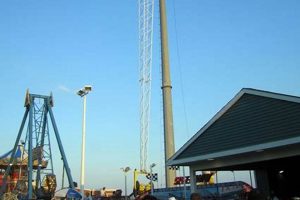Skyscrapers, towering structures that dominate skylines worldwide, have captured the imagination and serve as symbols of architectural prowess and urban development.
While “skyscraper” aptly describes these colossal buildings, there exists a rich vocabulary to convey their grandeur and architectural significance. These alternatives not only provide stylistic variety but also offer nuanced descriptions that highlight specific aspects of these architectural marvels.
In this article, we delve into the diverse lexicon surrounding skyscrapers, exploring the historical roots, cultural significance, and practical advantages of these linguistic alternatives.
1. High-rise
Among the diverse lexicon used to describe skyscrapers, “high-rise” stands out as a ubiquitous term that encapsulates their towering nature. Its widespread usage across multiple languages and cultures underscores its significance in the architectural vocabulary.
- Common Usage and Recognition: “High-rise” is a straightforward and easily recognizable term that conveys the primary characteristic of skyscrapers – their exceptional height. Its simplicity and clarity make it a popular choice in everyday conversations, news articles, and architectural discussions.
- Emphasis on Verticality: Unlike other terms like “tower” or “skyscraper,” which may also imply other architectural features, “high-rise” places a specific emphasis on the vertical dimension. It highlights the upward thrust of these structures, capturing their dominance over the surrounding cityscape.
- Functional Considerations: The term “high-rise” often carries practical implications related to the functionality and design of these buildings. High-rise structures are often associated with dense urban environments where land is scarce, leading to the need for vertical expansion to accommodate growing populations and businesses.
- Contextual Meaning: The term “high-rise” can take on different meanings depending on the context in which it is used. In cities with a cluster of skyscrapers, a “high-rise” may refer to a building of moderate height, while in areas with predominantly low-rise structures, the same term may be used to describe a relatively tall building.
In conclusion, “high-rise” serves as a versatile and widely recognized term within the lexicon of skyscraper descriptions. Its focus on verticality, functional considerations, and contextual usage makes it a valuable addition to the architectural vocabulary, providing a clear and concise way to refer to these towering structures.
2. Tower
Among the diverse lexicon used to describe skyscrapers, “tower” stands as a prominent and evocative term that captures their majestic height and architectural grandeur.
- Symbol of Strength and Dominance: The term “tower” has been used throughout history to describe tall, imposing structures that convey a sense of power and authority. Skyscrapers, with their towering presence, embody this symbolism, representing the economic and cultural might of the cities they grace.
- Vertical Emphasis: Like the term “high-rise,” “tower” emphasizes the vertical dimension of skyscrapers. It highlights their upward thrust, drawing attention to their ability to pierce the sky and dominate the surrounding cityscape.
- Historical Precedence: The use of “tower” to describe tall structures has deep historical roots. From ancient watchtowers to medieval castles, towers have served various purposes, including defense, observation, and communication. This historical context adds a layer of significance to its usage in the context of skyscrapers.
- Architectural Symbolism: In addition to its literal meaning, “tower” also carries symbolic connotations. It can represent ambition, progress, and human ingenuity. Skyscrapers, as symbols of architectural achievement, often embody these aspirations, reflecting the drive for innovation and the pursuit of new heights.
In conclusion, the term “tower” is a powerful and evocative word that captures the essence of skyscrapers. Its historical significance, vertical emphasis, and symbolic associations make it a valuable addition to the lexicon of skyscraper descriptions, providing a nuanced and meaningful way to describe these architectural marvels.
3. (Russian)
Within the lexicon of skyscraper descriptions, ” (Russian)” holds a unique place, offering a distinct perspective on these architectural marvels. Its literal translation as “sky-scratcher” captures the essence of skyscrapers as structures that reach towards the heavens, defying the limitations of the earthbound.
The term “” highlights the verticality and upward thrust that are characteristic of skyscrapers. It conveys a sense of ambition and progress, reflecting the drive to build structures that ascend to new heights. Furthermore, its Russian origin adds a cultural dimension to the description of skyscrapers, acknowledging the significant contributions of Russian architects and engineers to the field of high-rise construction.
Understanding the connection between ” (Russian)” and “other words for skyscraper” is important for several reasons. First, it broadens our understanding of the diverse vocabulary used to describe these architectural wonders. Each term, whether “skyscraper,” “high-rise,” “tower,” or “,” brings a unique perspective and cultural nuance to the discussion.
Second, it underscores the global nature of skyscraper architecture. Skyscrapers are not confined to a particular region or culture; they are a testament to human ingenuity and the desire to build upwards. The inclusion of “” in the lexicon of skyscraper descriptions acknowledges the contributions of Russian architects and engineers to this global architectural phenomenon.
In conclusion, exploring the connection between ” (Russian)” and “other words for skyscraper” enriches our understanding of the diverse vocabulary used to describe these architectural marvels. It highlights the verticality, ambition, and global nature of skyscrapers, providing a deeper appreciation for their cultural significance and architectural impact.
4. (Mandarin)
In the lexicon of skyscraper descriptions, ” (Mandarin)” stands as a significant term, offering a unique perspective on these architectural wonders. Its literal translation as “skyscraper” establishes a direc
t connection to the English term, highlighting the shared concept of structures that reach towards the heavens.
The use of “” in Mandarin captures the essence of skyscrapers as symbols of ambition and progress. The term conveys a sense of upward mobility and the drive to build structures that ascend to new heights. Furthermore, its Mandarin origin adds a cultural dimension to the description of skyscrapers, acknowledging the significant contributions of Chinese architects and engineers to the field of high-rise construction.
Understanding the connection between ” (Mandarin)” and “other words for skyscraper” is important for several reasons. First, it broadens our understanding of the diverse vocabulary used to describe these architectural marvels. Each term, whether “skyscraper,” “high-rise,” “tower,” or “,” brings a unique perspective and cultural nuance to the discussion.
Second, it underscores the global nature of skyscraper architecture. Skyscrapers are not confined to a particular region or culture; they are a testament to human ingenuity and the desire to build upwards. The inclusion of “” in the lexicon of skyscraper descriptions acknowledges the contributions of Chinese architects and engineers to this global architectural phenomenon.
In conclusion, exploring the connection between ” (Mandarin)” and “other words for skyscraper” enriches our understanding of the diverse vocabulary used to describe these architectural marvels. It highlights the shared concept of verticality and ambition, as well as the cultural and global dimensions of skyscraper architecture.
5. Wolkenkratzer (German)
In the diverse lexicon of skyscraper descriptions, “Wolkenkratzer (German)” holds a prominent place, offering a unique perspective on these architectural marvels. Its literal translation as “cloud scraper” captures the essence of skyscrapers as structures that reach towards the heavens, piercing the clouds and dominating the cityscape.
The term “Wolkenkratzer” highlights the verticality and upward thrust that are characteristic of skyscrapers. It conveys a sense of ambition and progress, reflecting the drive to build structures that ascend to new heights. Furthermore, its German origin adds a cultural dimension to the description of skyscrapers, acknowledging the significant contributions of German architects and engineers to the field of high-rise construction.
Understanding the connection between “Wolkenkratzer (German)” and “other words for skyscraper” is important for several reasons. First, it broadens our understanding of the diverse vocabulary used to describe these architectural wonders. Each term, whether “skyscraper,” “high-rise,” “tower,” or “Wolkenkratzer,” brings a unique perspective and cultural nuance to the discussion.
Second, it underscores the global nature of skyscraper architecture. Skyscrapers are not confined to a particular region or culture; they are a testament to human ingenuity and the desire to build upwards. The inclusion of “Wolkenkratzer” in the lexicon of skyscraper descriptions acknowledges the contributions of German architects and engineers to this global architectural phenomenon.
In conclusion, exploring the connection between “Wolkenkratzer (German)” and “other words for skyscraper” enriches our understanding of the diverse vocabulary used to describe these architectural marvels. It highlights the verticality, ambition, and global nature of skyscrapers, providing a deeper appreciation for their cultural significance and architectural impact.
6. Gratte-ciel (French)
In the diverse lexicon of skyscraper descriptions, “Gratte-ciel (French)” occupies a prominent position, offering a unique perspective on these architectural marvels. Its literal translation as “skyscraper” establishes a direct connection to the English term, highlighting the shared concept of structures that reach towards the heavens.
- Verticality and Ambition: Like other terms such as “high-rise” and “tower,” “Gratte-ciel” emphasizes the verticality and upward thrust that are characteristic of skyscrapers. It conveys a sense of ambition and progress, reflecting the drive to build structures that ascend to new heights.
- Cultural Context: The use of “Gratte-ciel” adds a cultural dimension to the description of skyscrapers, acknowledging the significant contributions of French architects and engineers to the field of high-rise construction. It reflects the unique architectural heritage and perspective of France.
- Linguistic Nuances: “Gratte-ciel” offers a slightly different linguistic nuance compared to the English term “skyscraper.” While both terms capture the essence of tall buildings that dominate the skyline, “Gratte-ciel” has a more poetic and descriptive quality, evoking the image of a structure that literally “scrapes the sky.”
- Global Recognition: The term “Gratte-ciel” has gained widespread recognition beyond French-speaking regions, becoming a commonly used term in architectural discourse and popular culture. Its inclusion in the lexicon of skyscraper descriptions underscores the global nature of skyscraper architecture.
Exploring the connection between “Gratte-ciel (French)” and “other words for skyscraper” enriches our understanding of the diverse vocabulary used to describe these architectural wonders. It highlights the shared concept of verticality and ambition, as well as the cultural and global dimensions of skyscraper architecture. By examining the different terms used across languages and cultures, we gain a deeper appreciation for the rich tapestry of architectural expression.
7. Rascacielos (Spanish)
In the diverse lexicon of skyscraper descriptions, “Rascacielos (Spanish)” stands as a significant term, offering a unique perspective on these architectural marvels. Its literal translation as “skyscraper” establishes a direct connection to the English term, highlighting the shared concept of structures that reach towards the heavens.
The use of “Rascacielos” adds a cultural dimension to the description of skyscrapers, acknowledging the significant contributions of Spanish architects and engineers to the field of high-rise construction. It reflects the unique architectural heritage and perspective of Spanish-speaking countries.
Understanding the connection between “Rascacielos (Spanish)” and “other words for skyscraper” is important for several reasons. First, it broadens our understanding of the diverse vocabulary used to describe these architectural wonders. Each term, whether “skyscraper,” “high-rise,” “tower,” or “Rascacielos,” brings a unique perspective and cultural nuance to the discussion.
Second, it underscores the global nature of skyscraper architecture. Skyscrapers are not confined to a particular region or culture; they are a testament to human ingenuity and the desire to build upwards. The inclusion of “Rascacielos” in the lexicon of skyscraper descriptions acknowledges the contributions of Spanish-speaking architects and engineers to this global architectural phenomenon.
In conclusion, exploring the connection between “Rascacielos (Spanish)” and
“other words for skyscraper” enriches our understanding of the diverse vocabulary used to describe these architectural marvels. It highlights the shared concept of verticality and ambition, as well as the cultural and global dimensions of skyscraper architecture. By examining the different terms used across languages and cultures, we gain a deeper appreciation for the rich tapestry of architectural expression.
Frequently Asked Questions about Other Words for Skyscraper
This section addresses some common questions and misconceptions surrounding the topic of “other words for skyscraper.” By providing clear and informative answers, we aim to enhance your understanding of the diverse vocabulary used to describe these architectural marvels.
Question 1: What is the difference between “skyscraper” and “high-rise”?
While both terms refer to tall buildings, “skyscraper” typically denotes buildings of exceptional height, often exceeding 150 meters or 500 feet. “High-rise,” on the other hand, is a more general term that encompasses buildings of significant height, but not necessarily as tall as skyscrapers.
Question 2: What is the origin of the term “skyscraper”?
The term “skyscraper” was first used in the late 19th century in the United States to describe the rapidly growing tall buildings in major cities like Chicago and New York. It vividly captures the image of buildings that seem to scrape the sky, hence the term “skyscraper.”
Question 3: Are there any cultural variations in the terms used for skyscrapers?
Yes, different languages and cultures have their own unique terms for skyscrapers. For example, in French, the term “gratte-ciel” is used, which literally means “sky-scraper.” Similarly, in Spanish, the term “rascacielos” is commonly employed, meaning “sky-scratcher.”
Question 4: What factors influence the choice of term used for a skyscraper?
The choice of term for a skyscraper can be influenced by various factors, including the height of the building, its architectural style, and the cultural context in which it is located. For instance, the term “tower” may be more appropriate for a particularly tall and slender building, while “skyscraper” is more commonly used for very tall buildings with a more massive structure.
Question 5: What are some of the benefits of using different terms for skyscrapers?
Employing a range of terms for skyscrapers allows for greater precision and nuance in describing these architectural structures. It enables us to distinguish between different types of tall buildings based on their height, design, and cultural significance.
Question 6: How can I learn more about the diverse vocabulary used to describe skyscrapers?
To further explore the vocabulary surrounding skyscrapers, you can refer to architectural dictionaries, online resources, and specialized books on the history and design of high-rise buildings. Additionally, visiting different cities and observing the architectural landscape can provide valuable insights into the diverse terms used worldwide.
By addressing these frequently asked questions, we hope to have clarified some of the key concepts and nuances related to the topic of “other words for skyscraper.” Understanding the diverse vocabulary used to describe these architectural marvels enhances our appreciation for the richness and variety of architectural expression.
As we move forward, the next section of our article will delve into the historical evolution of skyscraper terminology, tracing its origins and exploring the factors that have shaped its development over time.
Tips for Using Diverse Terminology for Skyscrapers
Enhancing your vocabulary for skyscrapers not only broadens your architectural lexicon but also enables you to engage in more nuanced discussions about these awe-inspiring structures.
Tip 1: Explore Etymological Roots: Delve into the origins of skyscraper terminology to gain a deeper understanding of their meanings. Trace the historical evolution of terms like “skyscraper,” “tower,” and “high-rise” to appreciate the cultural and linguistic influences that have shaped their usage.
Tip 2: Consider Context and Cultural Variations: Recognize that the choice of term for a skyscraper can vary depending on the context and cultural background. Familiarize yourself with the diverse terms used in different languages and regions to accurately describe these architectural marvels.
Tip 3: Understand Architectural Styles: Different architectural styles often necessitate the use of specific terms. For example, the term “spire” is commonly associated with Gothic skyscrapers, while “curtain wall” is frequently used to describe modern high-rises. Understanding these stylistic nuances enhances your ability to describe skyscrapers with precision.
Tip 4: Utilize Technical Terminology: Incorporate technical terms into your vocabulary to convey specific aspects of skyscraper design and construction. Terms like “facade,” “atrium,” and “superstructure” provide a more comprehensive understanding of these architectural marvels.
Tip 5: Engage in Architectural Discourse: Participate in discussions and forums related to skyscrapers to expand your knowledge and refine your use of terminology. Engage with architects, urban planners, and fellow enthusiasts to gain insights and perspectives on the diverse vocabulary surrounding skyscrapers.
By implementing these tips, you can effectively navigate the diverse terminology used to describe skyscrapers, enabling you to communicate about these architectural wonders with clarity and precision. Embrace the richness of the architectural lexicon and enhance your appreciation for the towering achievements of human ingenuity.
Conclusion
Our exploration of “other words for skyscraper” has illuminated the diverse vocabulary used to describe these architectural marvels. From “high-rise” to “tower” and beyond, each term captures a unique aspect of their towering presence and architectural significance.
Understanding the nuances of skyscraper terminology allows us to appreciate the cultural and historical contexts that have shaped their design. It also empowers us to engage in more informed discussions about these iconic structures, conveying their grandeur and architectural significance with greater precision.
As we continue to marvel at the ever-evolving skyline, let us embrace the richness of the architectural lexicon. By expanding our vocabulary for skyscrapers, we not only enhance our communication but also deepen our appreciation for the human ingenuity and creativity that these architectural wonders embody.







